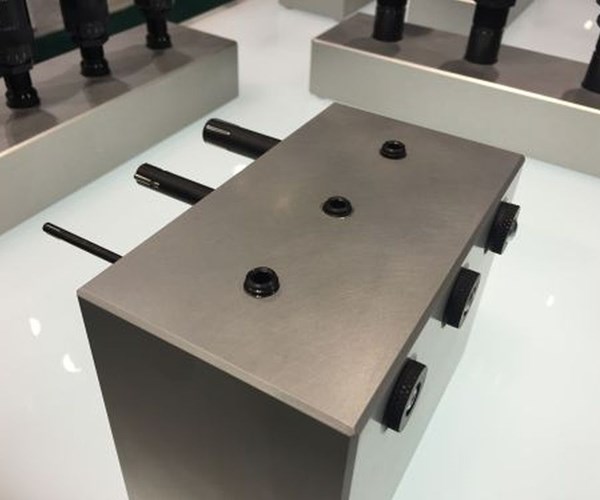Compact Burnishing Tools for Swiss Turning
With a unique design that allows adjustments to be made without removing the tool from the block, these burnishing tools produce exceptional micro-finishes in a variety of workpiece materials.

In the new 5918 series, the tool body is mounted inside the tool block with the adjustment knob protruding from the rear, allowing for adjustments without tool removal.
While attending IMTS in September, I stopped by the Monaghan Tooling Group booth. Of all the tooling on display, what really caught my eye was the line of Swiss ID burnishing tools by Elliott Tool Technologies, described as being ideal for accurate sizing, low micro-finishing, and surface hardening of ID holes down to 4 mm. In the new 5918 series, what was particularly striking was finding the tool body mounted completely inside the tool block so that the adjustment knob protrudes from the rear of the tool shank. This allows for adjustments for diameter to be made without removing the tool from the block.
As Swiss experts are well aware, burnishing improves surface irregularities and reduces tool marks, producing optimum surface finishes of 4-8 Ra in a single pass. This can eliminate secondary processes such as grinding, honing and polishing by automating those processes in the primary CNC machine. This slashes setup and processing times, as well as labor costs, while enhancing machinery usage and shopfloor productivity.
According to the company, compact burnishing tools are ideal for applications where the machine working envelope is limited, as is the case in most Swiss-type turning centers, small CNC turning centers, and when burnishing parts in subspindles where the machine working envelope is reduced. Burnishing is an ideal way to accurately hold diameter tolerances and produce micro-finishes in the range of 2 to 8 Ra in most steels, stainless steel, aluminum and other ductile metals that have a hardness of less than 45 Rc. Target markets include medical, fuel systems, fluid power and small automotive components.
In addition, wear parts reduce the total cost over the life of the tool, are easy to replace, with common tooling available from stock, and their operation and maintenance requires minimal training.

Burnishing improves surface irregularities and reduces tool marks, producing optimum surface finishes of 4-8 Ra in a single pass.
Related Content
-
Micromachining Fundamentals
A number of elements must come together to establish an effective process for machining at a micro level. Here we consider four.
-
Tool Path Improves Chip Management for Swiss-Type Lathes
This simple change to a Swiss-type turning machine’s tool path can dramatically improve its ability to manage chips.
-
Shop Sets its Sights on Precise Tool Alignment
A Wisconsin shop has found that visual tool alignment technology has improved tool life and surface finishes for its Swiss-type lathes while increasing throughput as well.











.jpg;maxWidth=300;quality=90)
